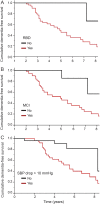Predictors of dementia in Parkinson disease: a prospective cohort study
- PMID: 25171928
- PMCID: PMC4180482
- DOI: 10.1212/WNL.0000000000000842
Predictors of dementia in Parkinson disease: a prospective cohort study
Abstract
Objective: We investigated an array of possible markers of early dementia in Parkinson disease.
Methods: We performed a comprehensive assessment of autonomic, sleep, psychiatric, visual, olfactory, and motor manifestations in 80 patients with Parkinson disease who were dementia-free at baseline. After 4.4 years' follow-up, patients were evaluated for dementia. Predictive variables were assessed using logistic regression adjusting for disease duration, follow-up duration, age, and sex.
Results: Of 80 patients, 27 (34%) developed dementia. Patients destined to develop dementia were older and more often male (odds ratio [OR] = 3.64, p = 0.023). Those with baseline mild cognitive impairment had increased dementia risk (OR = 22.5, p < 0.001). REM sleep behavior disorder at baseline dramatically increased dementia risk (OR = 49.7, p = 0.001); however, neither daytime sleepiness nor insomnia predicted dementia. Higher baseline blood pressure increased dementia risk (OR = 1.37 per 10 mm Hg, p = 0.032). Orthostatic blood pressure drop was strongly associated with dementia risk (OR = 1.84 per 10 mm Hg, p < 0.001); having a systolic drop of >10 mm Hg increased dementia odds 7-fold (OR = 7.3, p = 0.002). Abnormal color vision increased dementia risk (OR = 3.3, p = 0.014), but olfactory dysfunction did not. Among baseline motor variables, proportion of gait involvement (OR = 1.12, p = 0.023), falls (OR = 3.02, p = 0.042), and freezing (OR = 2.63, p = 0.013), as well as the Purdue Pegboard Test (OR = 0.67, p = 0.049) and alternate tap test (OR = 0.97, p = 0.033) predicted dementia.
Conclusion: Cardiovascular autonomic dysfunction, REM sleep behavior disorder, color discrimination ability, and gait dysfunction strongly predict development of dementia in Parkinson disease.
© 2014 American Academy of Neurology.
Figures
Comment in
-
Predictors of dementia in Parkinson disease: a prospective cohort study.Neurology. 2015 Mar 24;84(12):1285. doi: 10.1212/WNL.0000000000001408. Neurology. 2015. PMID: 25802273 No abstract available.
-
Author response.Neurology. 2015 Mar 24;84(12):1285-6. Neurology. 2015. PMID: 25969849 No abstract available.
References
-
- Svenningsson P, Westman E, Ballard C, Aarsland D. Cognitive impairment in patients with Parkinson's disease: diagnosis, biomarkers, and treatment. Lancet Neurol 2012;11:697–707 - PubMed
-
- Fosaa EB, Larsen JP, Wentzel-Larsen T, Alves G. What predicts mortality in Parkinson's disease? A prospective population-based long-term study. Neurology 2010;75:1270–1276 - PubMed
-
- Driver JA, Kurth T, Buring JE, Gaziano JM, Logroscino G. Parkinson disease and risk of mortality: a prospective comorbidity-matched cohort study. Neurology 2008;70:1423–1430 - PubMed
-
- Mayeux R, Denaro J, Hemenegildo N, et al. A population-based investigation of Parkinson's disease with and without dementia: relationship to age and gender. Arch Neurol 1992;49:492–497 - PubMed
Publication types
MeSH terms
Grants and funding
LinkOut - more resources
Full Text Sources
Other Literature Sources
Medical
Miscellaneous


